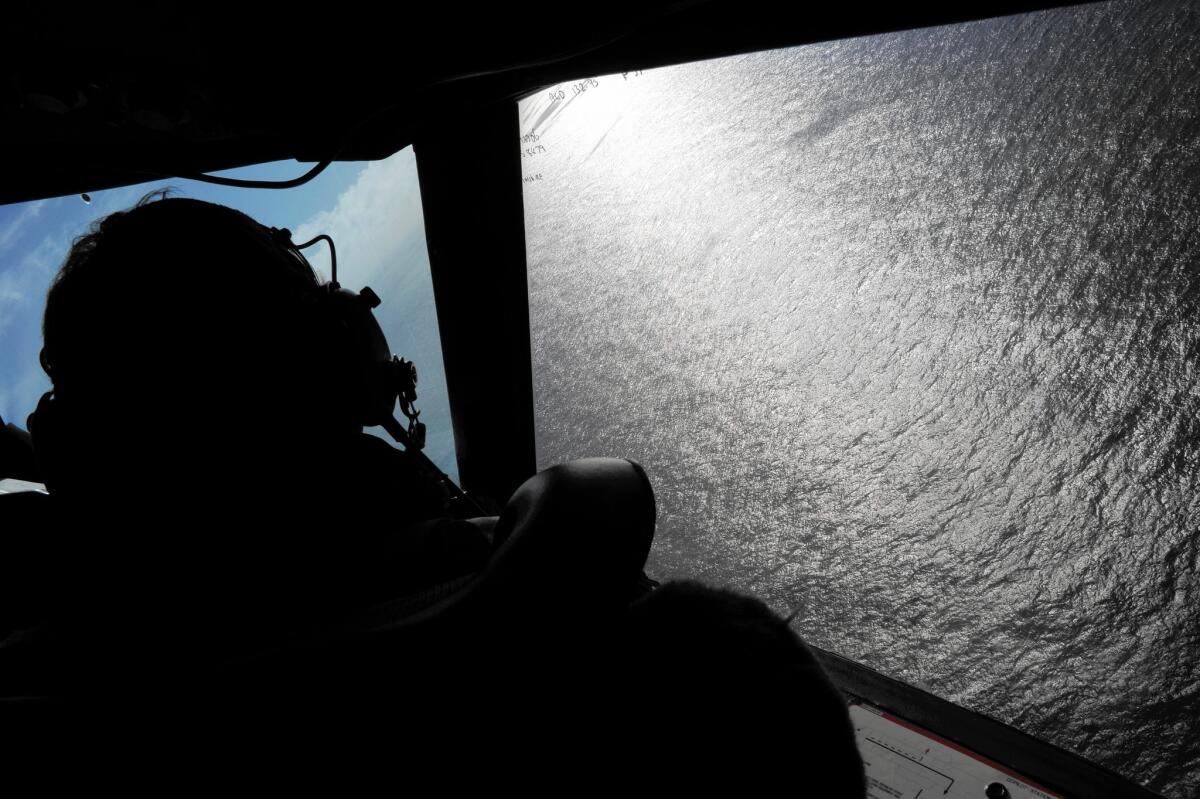Australia continues deep-sea search for Malaysia Airlines flight

- Share via
Reporting from PERTH, Australia — Somewhere off the coast of this western Australian city, most likely deep on the Indian Ocean seabed, may lie answers to the mysterious disappearance of Malaysia Airlines Flight 370.
Eight months after the Boeing 777 vanished, the international squadrons of reconnaissance aircraft and fleets of frigates and icebreakers are gone. So is the U.S. Navy’s 7th Fleet, which at one time contributed about 800 sailors to the search.
After combing 1.8 million square miles of ocean surface and chasing signals thought to come from the missing jet’s flight data recorders, searchers have not found a single piece of evidence of the plane.
All that remains now of the Australian-led search operations are three survey vessels with submersibles scanning as deep as 20,000 feet. After carefully covering about 1,900 square miles of ocean floor in the last month, the submersibles have discovered fascinating undersea crevices and inactive volcanoes, but no debris.
“I pray every day that today is the day,” said Judith Zielke, chief coordinator of Australia’s Flight 370 recovery efforts, conducted jointly with Malaysia and China.
Searchers remain optimistic that this latest phase, focusing on a new area farther southwest, will locate the wreckage and give some sense of closure to the families of the 239 passengers and crew members who were on board the plane.
But in an interview, Zielke acknowledged that the underwater effort was slow and painstaking, moving at about 2 miles an hour and sometimes sidelined by harsh weather. Experts liken it to a line of people looking for signs of a missing child in the woods, except the Flight 370 search area is the size of West Virginia and searchers must rely on sonar rather than sight. Zielke said it will take until April to finish searching the entire area.
Some experts have increasingly come to think that foul play was involved in the plane’s veering off course and presumed crash. A lack of physical evidence has also kept alive a host of conspiracy theories and speculation that the aircraft landed intact somewhere.
Families and relatives of those on board have initiated legal action and other steps to find answers.
About two months ago, Sarah Bajc, the 48-year-old partner of Philip Wood, one of three Americans on the flight, joined with others in hiring a private investigation firm with about $100,000 they raised. Bajc was in Beijing waiting for Wood when Flight 370 disappeared March 8 on its way there from Kuala Lumpur, Malaysia.
“I won’t give up hope until there’s proof otherwise,” said Bajc, speaking from Kuala Lumpur, where she moved this fall to teach. She and Wood, a 50-year-old IBM executive, had made plans to work in Malaysia for a couple of years, she said. Bajc doesn’t think authorities have been forthcoming about the investigation. “How can they be keeping everybody quiet?” she asked. “It’s just a giant mystery.”
For next of kin in China, whose citizens accounted for the majority of passengers on the flight, the angry public protests over Malaysia’s handling of the investigation have given way to more private displays of grief and frustration, as well as contacts with lawyers about pursuing claims against the airline. Some still visit a liaison office near Beijing for Flight 370 families, said Steve Wang, a spokesman for some of the Chinese families, but he said representatives there “couldn’t answer anything.”
Most experts subscribe to the official view, based on satellite communications with Flight 370, that the plane made a hard turn to the southwest after entering Vietnamese airspace shortly after taking off, then kept flying for several hours until it ran out of fuel and crashed in the Indian Ocean. Whether what happened was a result of mechanical failure, such as a fire on board that damaged the transponder, or a deliberate action, such as a hijacker intentionally disabling the plane’s location device, remains uncertain.
“I wasn’t as much on foul play, but I’m leaning more on that because, why fly it so long?” said Ron Bishop, an Australian search-and-rescue specialist and head of aviation at Central Queensland University. “If there was a catastrophic event, why did they go that long?”
Bishop dismisses the idea that the plane touched down safely on land. “What do you do with a 120-ton aircraft?” he asked. “It’s like stealing an elephant from a zoo. Where do you hide it?”
Malaysian authorities, who have been leading the investigation into Flight 370 crew members and other aspects of the flight, had the FBI examine the pilot’s in-home flight simulator. An FBI official, who was not authorized to speak publicly about the inquiry, said the bureau had offered further assistance, such as “forensic reviews and equipment examinations” once wreckage was located.
“But nothing has yet been found,” the official said, “so they haven’t taken us up on our offers.”
Charitha Pattiaratchi, a coastal oceanography expert in Perth who played a leading role in the early recovery research, says it’s not surprising that no physical evidence has been found. It took two years to recover the black boxes from an Air France flight that crashed in 2009, he said, and in that case searchers knew where the boxes were.
“They will find it, but it will take a long time, months to years,” he said of Flight 370 debris. But even then, he said, the flight recorder may not yield answers for the grieving. “They will certainly have closure in knowing the location where their loved ones may lie, but not really in terms of what actually happened.”
Zielke, Australia’s search coordinator, said she was “cautiously optimistic” that this latest undertaking will prove fruitful. She declined to say what authorities would do if this search also turned up empty. The Australian government has committed nearly $80 million over two years for the search operations, she said.
Michael Barr, an aviation safety expert at USC, said the efforts had not been in vain.
“Scientifically it’s worth it,” he said, noting that searchers had learned about better tracking systems to follow planes in remote regions. “But government, airlines and aircraft manufacturers will have to do a cost-benefit analysis of all this. They have decide whether it’s worthy of doing this.... Finally it becomes an economic and political decision if they don’t find it.”
Times staff writer Richard A. Serrano in Washington and Nicole Liu in The Times’ Beijing bureau contributed.
More to Read
Sign up for Essential California
The most important California stories and recommendations in your inbox every morning.
You may occasionally receive promotional content from the Los Angeles Times.














